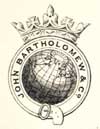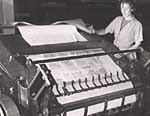The Bartholomew Archive
Background

The Bartholomew Archive documents nearly 180 years of map engraving, printing and publishing. Both the quantity and the range of material it contains make it one of the most comprehensive archives of its kind anywhere in the world.
The archive includes copies of all printing work the Edinburgh-based mapmaking firm undertook from 1877 to 1995. It also records the production and management of the firm across several generations of the Bartholomew family.
We are still receiving papers for the archive from the family of John C Bartholomew (1923-2008) and from individual members of the firm. Bartholomew donated maps and atlases to the National Library of Scotland over many years. We received the first business records on deposit in 1983. Most of the archive arrived in 1995, before the successor firm, HarperCollins, moved to Glasgow from Edinburgh. The archive also contains papers donated by the Bartholomew family and by individual members of the firm.
Mapmaking and printing processes

There is a wealth of material in the Bartholomew Archive which makes it a rich resource for studying the technical processes of mapmaking and printing. For instance:
- Original drawings and tracings and volumes of proof engravings
- Published copies of Bartholomew maps and atlases
- 20,000 sheets of preparation (working copy) and reference maps and plans, and other working material
- 3,000 copper plates
- 6,000 glass printing plates.
Geography and social history
As well as cartography, we can trace developments in related disciplines and organisations through the Bartholomew Archive – most notably geography.

John George Bartholomew (1860-1920), for example, helped set up the Royal Scottish Geographical Society and supported the proposal for a National Institute of Geography. These are documented in his extensive correspondence.
There is also much of interest in the archive for printing and social history more generally. Bartholomew were contract engravers and printers in their early years, and closely associated with other printers and publishers in Scotland and England. Among their work is a reprint of a 19th-century volume of portraits of London beggars showing stark images of poverty.
Top of page